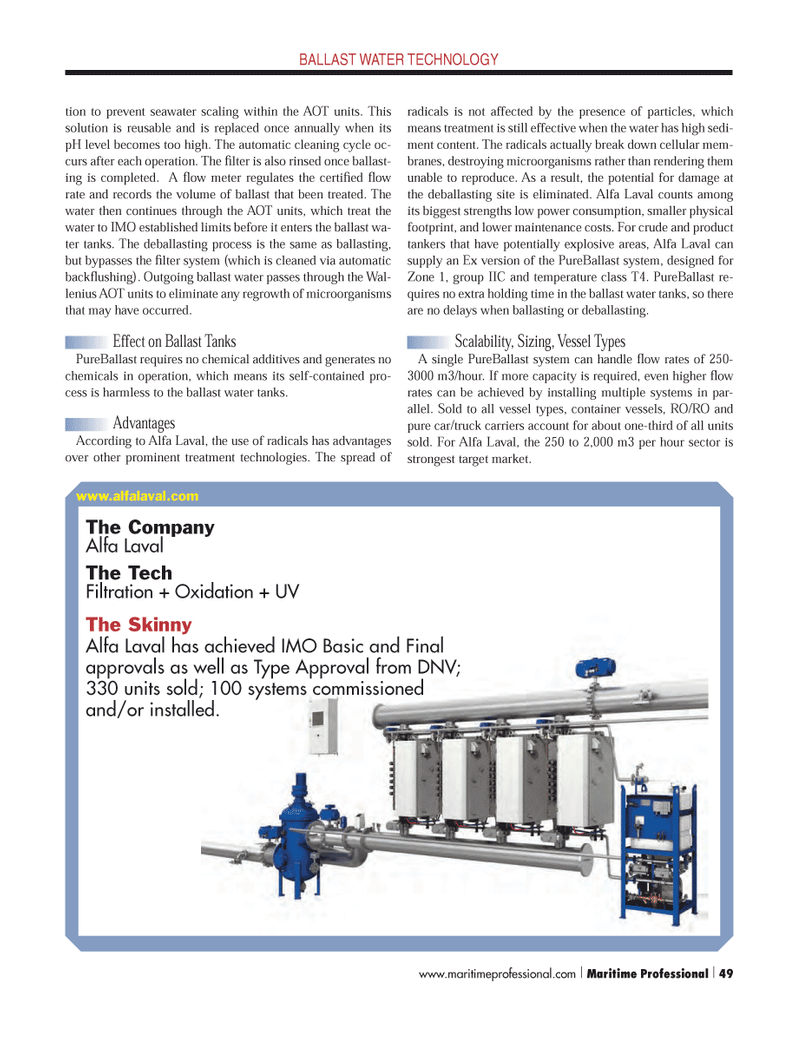
Page 49: of Maritime Logistics Professional Magazine (Q4 2012)
The Environment: Stewardship & Compliance
Read this page in Pdf, Flash or Html5 edition of Q4 2012 Maritime Logistics Professional Magazine
BALLAST WATER TECHNOLOGY tion to prevent seawater scaling within the AOT units. This solution is reusable and is replaced once annually when its pH level becomes too high. The automatic cleaning cycle oc- curs after each operation. The Þ lter is also rinsed once ballast- ing is completed. A ß ow meter regulates the certiÞ ed ß ow rate and records the volume of ballast that been treated. The water then continues through the AOT units, which treat the water to IMO established limits before it enters the ballast wa- ter tanks. The deballasting process is the same as ballasting, but bypasses the Þ lter system (which is cleaned via automatic backß ushing). Outgoing ballast water passes through the Wal- lenius AOT units to eliminate any regrowth of microorganisms that may have occurred. Effect on Ballast Tanks PureBallast requires no chemical additives and generates no chemicals in operation, which means its self-contained pro-cess is harmless to the ballast water tanks. Advantages According to Alfa Laval, the use of radicals has advantages over other prominent treatment technologies. The spread of radicals is not affected by the presence of particles, which means treatment is still effective when the water has high sedi- ment content. The radicals actually break down cellular mem- branes, destroying microorganisms rather than rendering them unable to reproduce. As a result, the potential for damage at the deballasting site is eliminated. Alfa Laval counts among its biggest strengths low power consumption, smaller physical footprint, and lower maintenance costs. For crude and product tankers that have potentially explosive areas, Alfa Laval can supply an Ex version of the PureBallast system, designed for Zone 1, group IIC and temperature class T4. PureBallast re- quires no extra holding time in the ballast water tanks, so there are no delays when ballasting or deballasting. Scalability, Sizing, Vessel Types A single PureBallast system can handle ß ow rates of 250- 3000 m3/hour. If more capacity is required, even higher ß ow rates can be achieved by installing multiple systems in par- allel. Sold to all vessel types, container vessels, RO/RO and pure car/truck carriers account for about one-third of all units sold. For Alfa Laval, the 250 to 2,000 m3 per hour sector is strongest target market. The Company Alfa LavalThe Tech Filtration + Oxidation + UVThe Skinny Alfa Laval has achieved IMO Basic and Final approvals as well as Type Approval from DNV; 330 units sold; 100 systems commissioned and/or installed. www.alfalaval.com www.maritimeprofessional.com | Maritime Professional | 49MP #4 34-49.indd 49MP #4 34-49.indd 4911/12/2012 9:50:09 AM11/12/2012 9:50:09 AM

 48
48

 50
50
